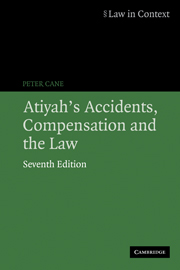Book contents
- Frontmatter
- Contents
- Preface
- List of abbreviations
- List of tables
- Table of legislation
- Table of cases
- Part One The Issues in Perspective
- Part Two The Tort System in Theory
- Part Three The Tort System in Operation
- 8 Claims and claimants
- 9 Tortfeasors and insurers
- 10 Trials and settlements
- Part Four Other Compensation Systems
- Part Five The Overall Picture
- Part Six The Future
- Index
9 - Tortfeasors and insurers
Published online by Cambridge University Press: 05 June 2012
- Frontmatter
- Contents
- Preface
- List of abbreviations
- List of tables
- Table of legislation
- Table of cases
- Part One The Issues in Perspective
- Part Two The Tort System in Theory
- Part Three The Tort System in Operation
- 8 Claims and claimants
- 9 Tortfeasors and insurers
- 10 Trials and settlements
- Part Four Other Compensation Systems
- Part Five The Overall Picture
- Part Six The Future
- Index
Summary
Defendants
In legal theory, the victim of personal injury who wishes to make a tort claim can sue either the person whose negligence actually caused the accident; or, where that person was acting in the course of employment at the time the tort was committed, the victim may sue the employer who is vicariously liable for the employee's tort; or both may be sued. As a matter of law, the tort victim (except in limited circumstances: 9.3) cannot sue the insurance company that has agreed to indemnify the tortfeasor or the employer against the tort liability. The insurer has committed no tort, and the only person with legal rights against the insurer is the insured. But if we look at the matter from a more practical and realistic viewpoint, we can see certain similarities between employers who are vicariously liable and liability insurers. Both may be legally liable for tort damages in the ultimate result; neither of them is (usually) in any way personally to blame for the victim's loss; both of them can act as ‘loss distributors’ in the sense that they can pass the cost of paying damages on to others, namely premium payers (in the case of insurers) and customers, employees and shareholders (in the case of employers). From this perspective, the fact that the employer can be sued by the tort victim while the other cannot is a technicality.
- Type
- Chapter
- Information
- Atiyah's Accidents, Compensation and the Law , pp. 222 - 259Publisher: Cambridge University PressPrint publication year: 2006

